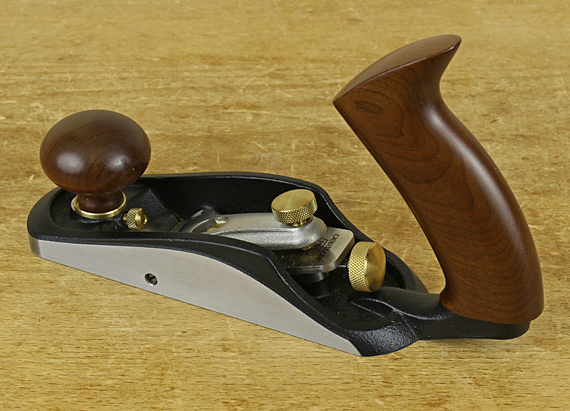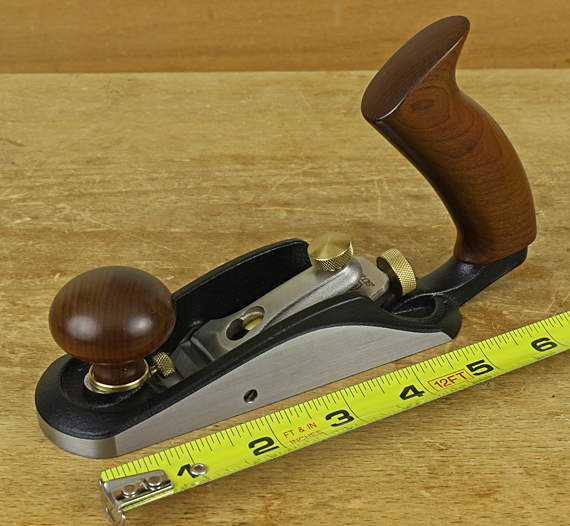
This is the Veritas Bevel-Up #1 plane, which I have been using for a year now. With a 1 7/32″-wide blade, it is indeed small but it works legitimately as a seriously useful plane. An ancillary tool, not a necessity, still I reach for it a lot more than I expected, so I want to share its merits with readers.
This plane excels for small or concentrated work where its maneuverability and the vision of the work that it affords are significant advantages. In fact, even large projects involve plenty of detail work, such as a leveling touch-up at the shoulder of an assembled mortise and tenon, and fitting small components, especially those involving angles and round-overs.
What makes this plane worthwhile for me is the feel. While there is some crossover in function with a block plane, this plane is different. Getting both hands in non-cramped positions on the handles of the BU#1 away from the sole affords feedback and control that I really appreciate. I can readily feel the tilt, and I like the excellent visual clearance. I also find that it handles significantly better than the Stanley style (bevel-down) #1.
I keep the BU#1 tuned about like a smoother with the blades mildly cambered. Because there is little momentum behind this small plane, it is particularly important to keep the blades sharp, especially if using a high attack angle.

This plane has a 15° bed so you can sharpen with a secondary bevel of 30° for a good all-round attack angle of 45°. It is also useful to keep a second blade sharpened to 40° or 45° for a 55° or 60° attack, respectively, to use as a touch up plane on difficult grain. The short sole helps in this function. By the way, I would prefer a 20° bed but I’ve covered that issue at length elsewhere.
Other features that I like are Veritas’ Norris-style combination adjuster with set screws near the front of the blade to make responsive lateral adjustments, and the adjustable front sole plate with a retainer set screw to easily regulate the width of the mouth. The sole of the BU#1 that I first received was slightly but significantly concave along its length but Lee Valley, being the great company that they are, exchanged it without bother. I slightly touched up the sole of the replacement, just because I’m picky.
The BU#1 does not suffer from the unfortunate handle design that plagues most other Veritas planes. (They can be replaced – talk to Bill Rittner.) It has only a mild curve but this works well for this plane; it feels right and comfortable to me.
My usual disclaimer: This review is unsolicited and uncompensated. My goal is only to point out good tools so you can make great stuff.


It looks like a small block plane with a tote. Same bed, same sole, same blade. Lee Valley says “similar in use to a block plane”.
This looks like a small block plane with a tote. Same blade, same sole. Lee Valley says it “functions the same as a block plane.
I purchased this same plane about 6 months ago. I really liked the feel of it in hand since the first use. I have several block planes and find them to be lacking in most applications. A quick edge bevel is about it for me and the block plane. I’ll be the first to admit that my working style may be the reason I don’t like block planes as other woodworkers seem to have a great relationship with them.
The Veritas #1 fills a void left by my dislike of block planes. You get good feedback from the wood / plane interface and great control with the handle.
Yes, Peter, I addressed the similarity of this plane with a block plane but it is significantly different, as I discussed. I think Lee Valley would not have bothered to design and produce the BU#1 if there was no significant difference between it and block planes, which they also produce. It’s really a matter of hands-on feel, admittedly a subjective matter.
Consider that, similarly, one could argue that a paring chisel is hardly different from a bench chisel except for the handle and length, yet it certainly is significantly different.
Dan, I agree.
Rob
That little handplane is awesome! My wife bought me one for Christmas about a year ago and I hadn’t really touched it until about a month ago. I had to make some octagon handles for my milkman’s workbench and I dreaded using a regular block plane to do it. So, I busted out that bevel-up #1 and made quick and enjoyable work out of them. It’s easier for me to use than a block plane when you really need to hog some material out. Since it has a tote, you can really put some power behind it.
Yea, Dean, hands-on feel and mechanics are so important in how we use tools. Intention to result: from brain to hand to tool with no weak or wobbly links.
Rob
I have a tote and knob accessory set for the Veritas block plane that turns it into something that looks a lot like that #1.
Hi Adrian,
Yes, same idea as the #1.
Here are the links if anyone’s interested. These fit their low-angle block plane.
https://www.leevalley.com/en-us/shop/tools/hand-tools/planes/maintenance-and-accessories/41715-vertical-tote-for-veritas-low-angle-block-plane?item=05P2218
https://www.leevalley.com/en-us/shop/tools/hand-tools/planes/maintenance-and-accessories/102530-front-knob-for-the-veritas-low-angle-block-plane?item=05P2204
https://www.leevalley.com/en-us/shop/tools/hand-tools/planes/block/47881-veritas-low-angle-block-plane
Prior to the BU#1 being available, I recall asking Lee Valley if the add-on handles would fit their standard-angle (20° bed) block plane and I think the answer was no. Maybe that has changed.
Rob
Rob,
You mentioned that the BU #1 handles better to you than the BD #1. Would you mind elaborating a little more on this and perhaps other reasons you like the BU better? Is the view of what you’re doing better? Lighter weight? Simply the mechanicals and ergonomics of it better? I know it’s subjective and a personal preference, I’m just curious. Thanks!
Jonathan
Hi Jonathan,
There is much more room to grasp the BU#1 handle. The BD#1 is pretty cramped. This gives me a better feel of the sole on the work. I can feel the tilt better if I’m doing and angled edge. Same for the front knob.
There is also more room to set up and adjust the BU. The features that Veritas uses are also very handy, such as the little set screws that make the lateral blade adjustment positive and easy. It’s just a more user-friendly plane overall. I reach for it much more often than I did the BD#1.
I hope this helps.
Rob